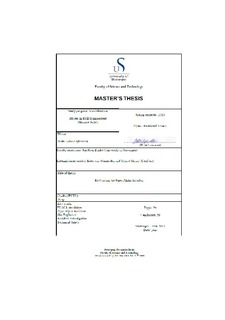| dc.description.abstract | The main objective of this thesis has been to re-visit the Piper Alpha accident using the latest version of the FLACS simulation code. In 1988/89 simulations of the gas explosion in the C Module of Piper Alpha were performed by Jan Roar Bakke and Idar Storvik at Christian Michelsen Institute, in conjunction with the investigation after the accident. For these simulations the computer code FLACS was used [1, 2]. In this thesis, the same simulation cases have been looked into, and the results obtained have then been compared to the results from the previous findings in 1988/89.
The continuous development of computer technology contributes to better and more accurate analysis tools. For assessing the consequences of gas explosions, FLACS is a well known tool. Improvements in the implementation of FLACS have contributed to increasingly more accurate calculations; becoming more and more consistent with practical experiments.
Explosion loads are determined by several factors, among other;
Geometry
Obstructions
Ventilation
Wind conditions
The new FLACS code allows for a more complex model than the code used for the previous studies, and also for adding effect of wind and ventilation. Therefore, in this thesis the effect of increasing degree of obstruction/congestion and the impact of natural ventilation inside the C Module on the Piper Alpha Platform is discussed. Various scenarios for the leakage dispersion, where leak rate, leak direction and leak position have been varied, are also presented.
A total of 21 cases have been simulated in this thesis. The first 15 scenarios that have been simulated in relation to this thesis, are based on the simulations carried out in 1988/89. Further, 6 new cases are dened based on the first 15 cases, and it is for these last 6 simulations that the effects of wind and leak dispersion has been taken into account.
The sources for modelling the geometry have not been unambiguous in this thesis; the modelling is based on model photographs and exterior photos of the platform.
The continuously development of the FLACS numerical model is illustrated
through the first 5 simulation cases in this thesis. For these cases the approximately same geometry model has been generated and used for the same scenarios as those performed in the simulations in 1988/89. The results for the next 10 simulation cases, 11-20, shows that the generated overpressure for a gas explosion in a partly confined area is dependent on the congestion inside the area, as well as the structure and equipment on the outside, and that increased congestion/obstruction increases the overpressure. The new simulations confirmed the findings from the 1988/89 simulations regarding the gas composition and the size of the gas cloud; condensate gives higher overpressure than natural gas for the same geometry and ignition location, and a gas cloud covering 50% of the volume gives a larger explosion than a gas cloud covering 30% of the volume.
In this thesis, it was also shown that the generated overpressure were higher for ignition near the wall vs. ignition in the centre of the module, for the same cloud composition and dimension.
The 6 last cases illustrates the impact of natural ventilation, leak rate, leak direction and leak position. It was found that a leak rate in the same direction as the natural ventilation at the leakage position inside the module, generated smaller gas clouds than that of a leakage direction in the opposite direction of the natural ventilation. The latter one gave too large gas clouds compared to what was expected.
It was observed that the effect of altering the leakage position by just 0.5 metre in the X-direction had a huge impact on the generated overpressure, and so had the leak rate. An increased leak rate (2,7 kg/s vs. 1,7kg/s) led to increased overpressure. | no_NO |
